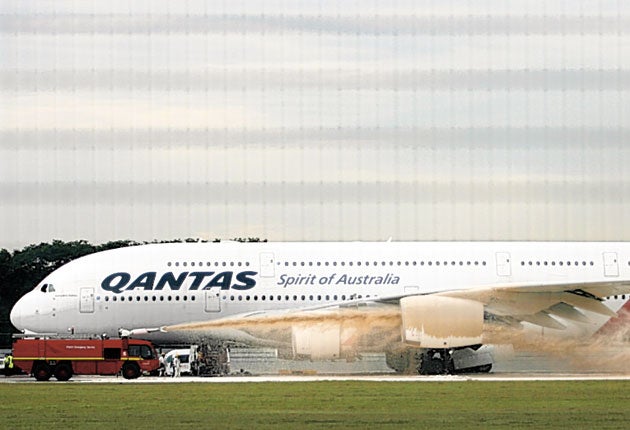We're in for the really long haul – Airbus drama spells delays
Grounding so many aircraft means chaos for the schedules, says Simon Calder

The plans of thousands of long-haul travellers are still up in the air, nine days after an engine on a Qantas Airbus A380 from London to Sydney caught fire and broke up shortly after taking off from Singapore.
Within hours of the incident, the Australian airline grounded its entire fleet of six "superjumbo" aircraft, the largest in the world. The A380s are normally deployed on its flagship route, from Sydney and Melbourne to London and Los Angeles, and carry upwards of 20,000 passengers each week.
While travel industry figures in the UK have been complimentary at the way the Australian carrier has dealt with the repercussions of the grounding, one senior executive said a prolonged delay could "wreak havoc" on Christmas and New Year schedules. Qantas is making no promises about when its A380 fleet will be cleared for take-off, after several earlier forecasts proved wrong.
Information obtained by The Independent from the airline's reservations system shows that all flights due to be operated by the A380 for the next two weeks have been replaced by smaller and older Boeing 747 jumbo jets, with around 100 fewer seats.
Qantas has transferred some of the passengers booked to travel with them to other airlines, and chartered capacity from British Airways to take passengers from Heathrow to Hong Kong and Singapore.
To cope with the absence of its largest aircraft, Qantas has come up with a complex "cascade" plan – downsizing aircraft across a range of routes. Links from London and Los Angeles are being served by smaller Boeing 747s, some of them normally deployed on services from Sydney to Tokyo and Hong Kong. These jumbos have in turn been replaced by Airbus A330s, taken from routes such as Perth to Singapore – whose passengers will find themselves flying on some of Qantas's older Boeing 767 jets.
A statement from the airline said "While Qantas is committed to bringing its A380s back into service as soon as possible, this contingency schedule has been designed to provide certainty for customers planning to travel in the near future."
Qantas has also issued an opaque statement saying that "engineers have been investigating the engines in detail and how their components and design perform under operational conditions – as opposed to the original out-of-factory expectations".
The re-introduction, when it happens, could be protracted, according to David Learmont, operations and safety editor of Flight Global publications: "They'll get the airplanes airborne one by one – they won't suddenly say the fleet is clear, they will clear them as they're ready."
As the Qantas grounding continues, fares on some routes have increased – particularly across the Pacific. Short-notice flights in economy class between Australia and California are being sold at well over £1,000 each way. From the UK, fares over the next two weeks on Qantas and its alliance partner, British Airways, are £100 higher than usual.
The potential financial damage to Qantas goes beyond the immediate costs associated with the incident and its aftermath. The airline spent hundreds of millions of dollars on fitting out its A380s to offer the highest standards – way ahead of those offered aboard the substitute Boeing 747 aircraft. In addition, there is always a risk in transferring passengers to rivals that the customers may not come back if they find the alternative carriers to their liking.
Routes already affected
The Qantas grounding of the A380 has had some intriguing repercussions for passengers, particularly business travellers booking at short notice or backpackers on round-the-world trips who want to change their flight dates.
Heathrow-Singapore
The Qantas Airbus A380 used on this link has been replaced by a Qantas Boeing 747. Travellers who insist on the "super-jumbo" may switch to Singapore Airlines, which is still operating A380s on the route, but this could prove expensive.
Singapore-Sydney
Passengers booking short-notice trips on Qantas are likely to find the only available seats involve a change of plane in another Australian city, such as Adelaide or Brisbane. The alternative is to fly non-stop on British Airways or Singapore Airlines, which are using Boeing 747s and 777s, but seats on these airlines are selling at a premium.
Singapore-Melbourne
Qantas customers anxious to get from Singapore to Melbourne are being offered a no-frills flight on the Qantas subsidiary, JetStar. It uses a narrow-bodied A320 and stops en route in Darwin, taking over four hours longer than the non-stop. Singapore Airlines is the alternative non-stop choice.
Subscribe to Independent Premium to bookmark this article
Want to bookmark your favourite articles and stories to read or reference later? Start your Independent Premium subscription today.

Join our commenting forum
Join thought-provoking conversations, follow other Independent readers and see their replies